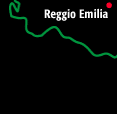|
Emilia
Romagna
This is the region of the Great River
Po, of the painter Parmigianino, of arcades and castles scattered
over the hills: the land of mists, poplars and bicycles celebrated
by Bernardo Bertolucci in his unforgettable film Novecento.
From Parma to Imola, there is not a town or village without
at least one stretch of road that is shaded in the summer
and sheltered in the winter.
Arcades dominate in Bologna, with more than 38 kilometres
of arcaded streets, where you can roam all over the old town
centre without an umbrella on a rainy day. The real heart
of the city is piazza Maggiore, where you can admire the
palazzo del Podestà, the palazzo
dei Banchi, the palazzo
dei Notai, the Comune (Town Hall) and the magnificent Basilica
of S. Petronio: they all overlook the magnificent bronze
statue of the god that tops the fountain of Neptune, by Giambologna,
one of the symbols of the city. Piazza Maggiore is the people’s
square, charming and exciting, a place for meeting people
and for strolling; the ideal shopping area is under the elegant
arcade of the Pavaglione: 400 metres of “salon”,
full of jeweller’s shops, boutiques and curios.
The Emilian gastronomic tradition is exceptional and includes
gnocchi fritti (fried dumplings) and piadine (flat bread),
coppa and culatelli (varieties of dry-cured ham), but the
glories of Bologna are its tagliatelle alla bolognese (noodles
with meat souse), tortellini (rings of stuffed pasta), lasagne and wonderful snacks, such as a bread roll with freshly sliced
mortadella sausage, not forgetting Sangiovese wine and Modena
balsamic vinegar..
Parma is a refined and cultivated city, with a tradition
of booksellers and fine art printers; the Biblioteca
Palatina library, in palazzo
della Pilotta, contains over 700,000
volumes including splendid artistic codices, manuscripts
and extremely rare Hebrew incunabula. Parma’s poetic
atmosphere continues in the charming parco Ducale, with many
fine buildings, and the Teatro Regio, a neoclassical masterpiece
and one of Italy’s most important opera houses. But
the symbol of the town is its wonderful Romanesque Duomo,
with decorations and sculptures telling the story of the
city in stone. The Province of Parma is full of churches,
oratories, abbeys and castles dating back to the Middle Ages,
but also of strongholds and fortified towns ready to repel
enemies or welcome ladies and gallant knights. Roccabianca looks like something out of a fairytale: the backdrop of
its scenic square is the façade of a castle that was
a gift of love from a noble knight to his beloved Bianca
Pellegrini. The romantic story continues in the Torrechiara
castle, perched on a hilltop, with perfect outlines visible
from far off: a true mediaeval fortress, menacing and stark.
This is where the two lovers used to meet secretly: the Camera
d’Oro (golden room) depicts their love story in the
frescoes on the ceiling and the wall coffers decorated with
interlaced hearts and initials. The castle is close to Langhirano,
where the tall narrow windows of the buildings and the wide
terraces are essential factors for the production of prosciutto
crudo di Parma (Parma dry-cured ham), famous all over the
world and Parmigiano Reggiano (Reggiano Parmesan cheese),
which is king in the town of Soragna.
Reggio Emilia is a city of arcades and bell towers decorated
with many contemporary works; in the cloister of the thirteenth-century
monastery of San Domenico stands Less
than by the sculptor
Robert Morris: a big, bronze, headless figure bearing a heavy
amphora on its back.
Two other interesting cities are Ferrara, with its wonderful
palazzo dei Diamanti (palace of the diamonds), faced with
elegant pointed blocks, which houses the important Pinacoteca
Nazionale picture gallery, and Ravenna, world famous for
its mosaics: these treasures of humanity are in the San
Vitale complex and the eye never tires of the marvellous Byzantine
pictures.
But it is the Po, a river full of life, crowded with canoes
and pleasure boats all the year round, and the villages along
its banks that are the most authentic and fascinating part
of a region made up of special atmospheres, where even the
mist, in winter, gives the landscape a mysterious charm and
where every place is steeped in the music and memories of
Giuseppe Verdi, who was born in this area. Brescello, the
village of don Camillo e Peppone, still calls to mind the
romantic battles between the mayor and the parish priest,
who came to be loved throughout the world. Piacenza is a
beautiful city, reserved, with buildings that have plain
facades but on the inside are filled with splendid gardens
and courtyards, statues and staircases; however, their luxury
is always restrained and discreet: in palazzo Farnese everybody
is charmed by the Madonna adoring the Child by Sandro Botticelli.
Motor enthusiasts will, on the other hand, be charmed by
the Ferrari gallery in Maranello. And, of course, admirers
of Federico Fellini just have to go to Rimini, the “queen
of beaches”, crowded with “vitelloni” (idlers),
where everything reminds us of the great Master.
For more information click on:
Emilia Romagna  ENTER ENTER
|



|


















